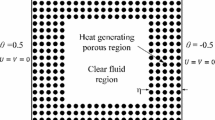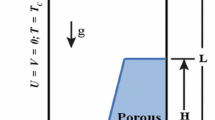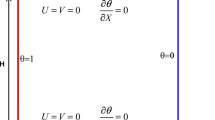Abstract
In this paper, we present a numerical investigation of natural convection heat transfer and entropy generation for a rhombic enclosure with inclination angle, ϕ = 30°, filled with a porous medium. The left and right surface walls of the enclosure are confined to cold temperature bath while we impart non-uniform, varying temperature distribution with unequal phase angles along the top and bottom wall. The flow inside the enclosure is steady, two-dimensional, incompressible and laminar, and the working fluid is air (Pr = 0.71). Numerical experiments have been performed using finite element method-based software COMSOL Multiphysics 5a for Darcy number and Rayleigh number in the extent of 10−4–10−2 and 103–106, respectively, in addition to phase deviation angles varying in the range from 0 to π. The amplitude parameter associated with the temperature delineation of the bottom and top walls is kept constant. The realizations from the numerical investigation are exhibited by streamlines and isotherms, local and average heat transfer Nusselt number along with the local distribution of heat transfer and fluid friction irreversibilities. The rate of heat transfer demonstrates non-monotonic trends and can be considerably influenced by the interplay of the phase shift angle, Rayleigh number and Darcy number. Upon increasing the value of phase shift angle from 0 to π, average Nusselt number initially decreases and thereafter shows an increase in its value. As the Darcy number increases, average Nusselt number for the bottom wall increases, while for the top wall it strongly depends on phase shift angle. In terms of entropy generation, it is found that the significant contributor to irreversibility is induced by heat transfer and the location of maximum entropy varies with the change in phase angle. More specifically, minimum entropy generation for any value of Rayleigh number and Darcy number is obtained for a phase shift angle of π/4 and maximum for 3π/4. The concomitant transport characteristics bear significance from the context of design of thermal systems pertaining to the theme of non-uniform heating with the phase angle being a crucial design parameter.













Similar content being viewed by others
Abbreviations
- \(c_{\text{p}}\) :
-
Specific heat of the fluid at constant pressure (J kg−1 K−1)
- Da:
-
Darcy number
- g :
-
Acceleration under the influence of gravity (m s−2)
- h :
-
Coefficient of heat transfer (W m−2 K−1)
- \(k\) :
-
Conductivity (thermal) (W m−1 K−1)
- K :
-
Permeability (m2)
- \(L\) :
-
Rhombic enclosure length (m)
- Nu:
-
Local Nusselt number
- \(\overline{\text{Nu}}\) :
-
Average Nusselt number
- p :
-
Pressure (N m−2)
- P :
-
Non-dimensional pressure
- Pr:
-
Prandtl number
- Ra:
-
Rayleigh number
- S :
-
Total dimensionless entropy generation
- S θ :
-
Dimensionless entropy generation due to heat transfer
- S ψ :
-
Dimensionless entropy generation due to fluid friction
- \(T\) :
-
Temperature (K)
- U, V :
-
Dimensionless x and y velocity components, respectively
- \(u,v\) :
-
X and y velocity components, respectively (m s−1)
- \(x,y\) :
-
Axial and transverse coordinates, respectively (m)
- α :
-
Thermal diffusivity (m2 s−1)
- β :
-
Coefficient of thermal expansion (s−1)
- θ :
-
Dimensionless temperature
- µ :
-
Dynamic viscosity (kg m−1 s−1)
- ν :
-
Kinematic viscosity (m2 s−1)
- ξ :
-
Irreversibility ratio
- \(\rho\) :
-
Density of fluid (kg m−3)
- φ :
-
Phase shift angle
- ϕ :
-
Inclination angle of enclosure
- avg:
-
Average
- b:
-
Bottom wall
- c:
-
Cold wall
- r:
-
Right wall
- l:
-
Left wall
- min:
-
Minimum
- max:
-
Maximum
References
Nield DA, Bejan A. Convection in porous media, vol. 3. New York: Springer; 2006.
Vafai K, editor. Handbook of porous media. 2nd ed. New York: Taylor and Francis; 2005.
Ingham DB, Pop I, editors. Transport phenomena in porous media, vol. 3. Amsterdam: Elsevier; 2005.
Vafai K, Hadim H. Overview of current computational studies of heat transfer in porous media and their applications-natural convection and multiphase heat transfer. In: Minkowycz WJ, Sparrow EM, editors. Advances in numerical heat transfer, vol. 2. Boca Raton: CRC Press; 2018. pp. 291–329.
Bejan A, Dincer I, Lorente S, Miguel AF, Reis AH. Porous and complex flow structures in modern technologies. New York: Springer; 2004.
Mehryan SAM, Izadi M, Sheremet MA. Analysis of conjugate natural convection within a porous square enclosure occupied with micro polar nanofluid using local thermal non-equilibrium model. J Mol Liq. 2018;250:353–68.
Meshram P, Bhardwaj S, Dalal A, Pati S. Effects of the inclination angle on natural convection heat transfer and entropy generation in a square porous enclosure. Numer Heat Transf. 2016;70:1271–396.
Basak T, Roy S, Paul T, Pop I. Natural convection in a square cavity filled with a porous medium: effects of various thermal boundary conditions. Int J Heat Mass Transf. 2006;49:1430–41.
Datta P, Mahapatra PS, Ghosh K, Manna NK, Sen S. Heat transfer and entropy generation in a porous square enclosure in presence of an adiabatic block. Transp Porous Media. 2016;111:305–29.
Biswas N, Manna NK, Datta P, Mahapatra PS. Analysis of heat transfer and pumping power for bottom-heated porous cavity saturated with Cu–water nanofluid. Powder Technol. 2018;326:356–69.
Biswas N, Manna NK, Mahapatra PS. Merit of non-uniform over uniform heating in a porous cavity. Int Commu Heat Mass Transf. 2016;78:135–44.
Varol Y, Oztop HF, Pop I. Numerical analysis of natural convection for a porous rectangular enclosure with sinusoidally varying temperature profile on the bottom wall. Int Commu Heat Mass Transf. 2008;35:56–64.
Torki M, Etesami N. Experimental investigation of natural convection heat transfer of SiO2/water nanofluid inside inclined enclosure. J Therm Anal Calorim. 2020;139:1565–74.
Bhardwaj S, Dalal A. Analysis of natural convection heat transfer and entropy generation inside porous right-angled triangular enclosure. Int J Heat Mass Transf. 2013;65:500–13.
Bhardwaj S, Dalal A, Pati S. Influence of wavy wall and non-uniform heating on natural convection heat transfer and entropy generation inside porous complex enclosure. Energy. 2015;79:467–81.
Varol Y, Oztop HF, Pop I. Entropy generation due to natural convection in non-uniformly heated porous isosceles triangular enclosures at different positions. Int J Heat Mass Transf. 2009;52:1193–205.
Dogonchi AS, Ismael MA, Chamkha AJ, Ganji DD. Numerical analysis of natural convection of Cu–water nanofluid filling triangular cavity with semicircular bottom wall. J Therm Anal Calorim. 2019;135(6):3485–97.
Dutta S, Biswas AK, Pati S. Natural convection heat transfer and entropy generation inside porous quadrantal enclosure with non-isothermal heating at the bottom wall. Numer Heat Transf. 2018;73(4):222–40.
Dutta S, Biswas AK, Pati S. Numerical analysis of natural convection heat transfer and entropy generation in a porous quadrantal cavity. Int J Numer Methods Heat Fluid Flow. 2019;29:4826–49.
Dutta S, Biswas AK. Entropy generation due to natural convection with non-uniform heating of porous quadrantal enclosure—a numerical study. Front Heat Mass Transf. 2018;10(8):1–12.
Astanina MS, Sheremet MA, Oztop HF, Hamdeh NA. MHD natural convection and entropy generation of ferrofluid in an open trapezoidal cavity partially filled with a porous medium. Int J Mech Sci. 2018;136:493–502.
Varol Y, Oztop HF, Pop I. Natural convection in right-angle porous trapezoidal enclosure partially cooled from inclined wall. Int Commu Heat Mass Transf. 2009;36:6–15.
Varol Y, Oztop HF, Pop I. Entropy analysis due to conjugate-buoyant flow in a right-angle trapezoidal enclosure filled with a porous medium bounded by a solid vertical wall. Int J Therm Sci. 2009;48:1161–75.
Al-Rashed AAA, Sheikhzadeh GA, Aghaei A, Monfared F, Shahsavar A, Afrand M. Effect of a porous medium on flow and mixed convection heat transfer of nanofluids with variable properties in a trapezoidal enclosure. J Therm Anal Calorim. 2020;139:741–54.
Hoghoughi G, Izadi M, Oztop HF, Hamdeh NA. Effect of geometrical parameters on natural convection in a porous undulant-wall enclosure saturated by a nanofluid using Buongiorno’s model. J Mol Liq. 2018;255:148–59.
Pal GC, Goswami N, Pati S. Numerical investigation of unsteady natural convection heat transfer and entropy generation from a pair of cylinders in a porous enclosure. Numer Heat Transf. 2018;74(6):1323–41.
Bhowmick D, Randive PR, Pati S, Agrawal H, Kumar A, Srivastava PK. Natural convection heat transfer and entropy generation from a heated cylinder of different geometry in an enclosure with non-uniform temperature distribution on the walls. J Therm Anal Calorim. 2019. https://doi.org/10.1007/s10973-019-09054-2.
Bhowmick D, Chakravarthy S, Randive PR, Pati S. Numerical investigation on the effect of magnetic field on natural convection heat transfer from a pair of embedded cylinders within a porous enclosure. J Therm Anal Calorim. 2020. https://doi.org/10.1007/s10973-020-09411-6.
Baranyi L. Computation of unsteady momentum and heat transfer from a fixed circular cylinder in laminar flow. J Comput App Mech. 2003;4(1):13–25.
Dhiman A, Gupta R, Baranyi L. Cross-buoyancy mixed convection from a heated cylinder placed asymmetrically in a channel. Int Commun Heat Mass Transf. 2018;95:139–46.
Mohebbi R, Mehryan SAM, Izadi M, Mahian O. Natural convection of hybrid nanofluids inside a partitioned porous cavity for application in solar power plants. J Therm Anal Calorim. 2019;137:1719-33.
Sheikholeslami M, Rokni HB. Numerical simulation for impact of Coulomb force on nanofluid heat transfer in a porous enclosure in presence of thermal radiation. Int J Heat Mass Transf. 2018;118:823–31.
Sheikholeslami M, Gorji-Bandpy M, Vajravelu K. Lattice Boltzmann simulation of magnetohydrodynamic natural convection heat transfer of Al2O3–water nanofluid in a horizontal cylindrical enclosure with an inner triangular cylinder. Int J Heat Mass Transf. 2015;80:16–25.
Sheikholeslami M, Shehzad SA. Numerical analysis of Fe3O4–H2O nanofluid flow in permeable media under the effect of external magnetic source. Int J Heat Mass Transf. 2018;118:182–92.
Sheikholeslami M, Seyednezhad M. Simulation of nanofluid flow and natural convection in a porous media under the influence of electric field using CVFEM. Int J Heat Mass Transf. 2018;120:772–81.
Sheikholeslami M. New computational approach for exergy and entropy analysis of nanofluid under the impact of Lorentz force through a porous media. Comput Methods Appl Mech Eng. 2019;344:319–33.
Mehrizi AA, Sedighi K, Farhadi M, Sheikholeslami M. Lattice Boltzmann simulation of natural convection heat transfer in an elliptical-triangular annulus. Int Commun Heat Mass Transf. 2013;48:164–77.
Ashorynejad HR, Mohamad AA, Sheikholeslami M. Magnetic field effects on natural convection flow of a nanofluid in a horizontal cylindrical annulus using lattice Boltzmann method. Int J Therm Sci. 2013;64:240–50.
Sheikholeslami M. CuO–water nanofluid flow due to magnetic field inside a porous media considering Brownian motion. J Mol Liq. 2018;249:921–9.
Sheikholeslami M. Numerical investigation of nanofluid free convection under the influence of electric field in a porous enclosure. J Mol Liq. 2018;249:1212–21.
Sheikholeslami M, Zeeshan A, Majeed A. Control volume based finite element simulation of magnetic nanofluid flow and heat transport in non-Darcy medium. J Mol Liq. 2018;268:354–64.
Sheikholeslami M, Shamlooei M. Fe3O4–H2O nanofluid natural convection in presence of thermal radiation. Int J Hydrog Energy. 2017;42(9):5708–18.
Sheikholeslami M. Numerical simulation of magnetic nanofluid natural convection in porous media. Phys Lett A. 2017;381(5):494–503.
Sheikholeslami M, Sheremet MA, Shafee A, Tlili I. Simulation of nanoliquid thermogravitational convection within a porous chamber imposing magnetic and radiation impacts. Physica A Stat Mech Appl. 2020. https://doi.org/10.1016/j.physa.2019.124058.
Moukalled F, Darwish M. Natural convection heat transfer in a porous rhombic annulus. Numer Heat Transf. 2010;58(2):101–24.
Moukalled F, Darwish M. Double diffusive natural convection in a porous rhombic annulus. Numer Heat Transf. 2013;64(5):378–99.
Anandalakshmi R, Basak T. Heat flow visualization for natural convection in rhombic enclosures due to isothermal and non-isothermal heating at the bottom wall. Int J Heat Mass Transf. 2012;55:1325–42.
Anandalakshmi R, Basak T. Heatline analysis for natural convection within porous rhombic cavities with isothermal/non isothermal hot bottom wall. Ind Eng Chem Res. 2012;51:2113–32.
Anandalakshmi R, Basak T. Analysis of natural convection via entropy generation approach in porous rhombic enclosures for various thermal aspect ratios. Int J Heat Mass Transf. 2013;64:224–44.
Anandalakshmi R, Basak T. Analysis of energy management via entropy generation approach during natural convection in porous rhombic enclosures. Chem Eng Sci. 2012;79:75–93.
Anandalakshmi R, Basak T. Heatline based thermal management for natural convection in porous rhombic enclosures with isothermal hot side or bottom wall. Energy Convers Manag. 2013;67:287–96.
Bejan A. Entropy generation through heat and fluid flow. New York: Wiley; 1982.
Bejan A. Entropy generation minimization. Boca Raton: CRC Press; 1996.
Dutta S, Goswami N, Biswas AK, Pati S. Numerical investigation of magnetohydrodynamic natural convection heat transfer and entropy generation in a rhombic enclosure filled with Cu–water nanofluid. Int J Heat Mass Transf. 2019;136:777–98.
Poulikakos D. Natural convection in a confined fluid-filled space driven by a single vertical wall with warm and cold regions. J Heat Transf. 1985;107:867–76.
Basak T, Chamkha AJ. Heatline analysis on natural convection for nanofluids confined within square cavities with various thermal boundary conditions. Int J Heat Mass Transf. 2012;55:5526–43.
Bilgen E, Yedder RB. Natural convection in enclosure with heating and cooling by sinusoidal temperature profiles on one side. Int J Heat Mass Transf. 2007;50:139–50.
Deng QH, Chang JJ. Natural convection in a rectangular enclosure with sinusoidal temperature distributions on both side walls. Numer Heat Transf. 2008;54:507–24.
Kaluri RS, Basak T, Roy S. Heatline approach for visualization of heat flow and efficient thermal mixing with discrete heat sources. Int J Heat Mass Transf. 2010;53:3241–61.
Zienkiewicz OC, Taylor RL. The finite element method. 4th ed. New York: McGraw-Hill; 1991.
Author information
Authors and Affiliations
Corresponding author
Additional information
Publisher's Note
Springer Nature remains neutral with regard to jurisdictional claims in published maps and institutional affiliations.
Rights and permissions
About this article
Cite this article
Dutta, S., Goswami, N., Pati, S. et al. Natural convection heat transfer and entropy generation in a porous rhombic enclosure: influence of non-uniform heating. J Therm Anal Calorim 144, 1493–1515 (2021). https://doi.org/10.1007/s10973-020-09634-7
Received:
Accepted:
Published:
Issue Date:
DOI: https://doi.org/10.1007/s10973-020-09634-7




